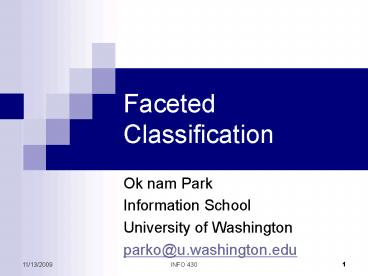Faceted Classification - PowerPoint PPT Presentation
1 / 29
Title:
Faceted Classification
Description:
The broad categories into which the subject area is divided. A facet consists ' ... The Idea Plane the progress of analyzing a subject field into facets ... – PowerPoint PPT presentation
Number of Views:805
Avg rating:3.0/5.0
Title: Faceted Classification
1
Faceted Classification
- Ok nam Park
- Information School
- University of Washington
- parko_at_u.washington.edu
2
Overview
- Part 1 Background of Faceted Classification
- Part 2 Modeling Faceted Classifications
3
Enumerated classification vs. faceted
classification
- Enumerated classification
- One-dimensional
- Rigid and hierarchical
- Analytico-Synthetic (Faceted Classification)
- Multi-dimensional
4
History of Faceted Classification
- A Hindu mathematician
- Working as a librarian
- Starts from the limits of
- traditional enumerative classification systems
- Attempts to describe
- the entire universe of ideas
- 1930s
- Colon Classification Analytico-synthetic
classification system (1933)
Ranganathan (1892 - 1972)
5
Ranganathans 5 Facets
- Personality Who
- Matter What
- Energy How
- Space Where
- Time When
6
Basic Ranganathan
- Analyze each document
- Identify concepts in a facet
- Establish an order for facets (Ranganathans is
P-M-E-S-T).
7
Examples
- Ranganathan's Colon Classification
- The design of wooden furniture in 18th century
America
8
Examples
- Ranganathan's Colon Classification
- The design of wooden furniture in 18th century
America - Personality Furniture
- Matter Wood
- Energy Design
- Space America
- Time 18th Century
- Furniture Wood Design America 18th Century
9
Facets
- The broad categories into which the subject area
is divided. A facet consists ... of a group of
terms that represents one, and only one,
characteristic of division of a subject
field....no two facets may contain terms that
could represent the same concepts. Louise
Spiteri - A "clearly defined, mutually exclusive, and
collectively exhaustive aspects, properties or
characteristics of a class or specific subject"
Maple
10
Facet Analysis
- Facet analysis is a mental process involving
analysis of a subject into its facets based on a
set of postulates, canons and principles. It
provides a framework to accommodate various types
of terms, along with rules for their
combination.K. Kumar
11
Faceted Classification
- FA (Facet Analysis) - (analytical technique)
- Analysis Break down
- FC (Facet Classification) - (synthetic structure)
- Synthesis combine relevant facets
12
Facets, anyone? Recipes
13
Epicurious.com
- Cuisine
- Special considerations
- Meal/Course
- Dish
- Main Ingredients
- Preparation methods
- Season/Occasion
14
When to make a faceted classification
- When not to make a faceted classification
- One dimension
- Hierarchies (The rule of inheritance)
- When to make a faceted classification
- Multiple access points
15
Examples
- Faceted Classification
- Epicurious http//www.epicurious.com
- Wine.com http//www.wine.com
- Flamenco http//bailando.sims.berkeley.edu/flamenc
o.html - Images of England http//www.imagesofengland.org.u
k/default.aspx - lawforwa.org http//www.lawforwa.org/home.html
- FAT-HUM Project http//www.ucl.ac.uk/fatks/index.h
tm - Tools
- FacetMaps Wine demonstration http//facetmap.com/
download/starterKit.jsp - Siderean software http//www.siderean.com/
- http//www.siderean.com/medidemo.jsp
- Endeca software http//endeca.com/
- Adiuri systems http//www.adiuri.com/facet.htm
16
Part 2 Modeling Faceted Classification
17
Planes of Work (Spiteri)
- The Idea Plane the progress of analyzing a
subject field into facets - The Verbal Plane the process of choosing
appropriate terminology
18
Idea Plane Principles for the Choice of Facets
- Differentiation
- Divide by a clearly defined characteristic of
division - E.g., Humans by Gender
- Relevance
- Reflect the purpose and scope of the
classification system - E.g., Children by Grade, but not for Dogs
- Ascertainability
- Definite and ascertainable facts
- E.g., Date of birth for Humans, Breed for Dogs
- Permanence
- Permanent qualities of the entity
- E.g., Color wouldnt work for chameleons
19
Idea Plane Principles for the Choice of Facets
- Mutual Exclusivity
- Facets represent only one characteristic
- Exhaustivity
- Fundamental Categories
- Categories should be derived from the domain
20
Idea Plane Principles for the Citation Order of
Facets and Foci
- Relevant Succession
- Chronological Order
- Alphabetical Order
- Spatial/Geometric Order
- Simple to Complex Order (or Complex to Simple)
- Canonical Order
- Increasing Quantity (or Decreasing Quantity)
- Consistent Succession
21
Verbal Plane - Terminology
- Context (for example)
- Grain dishes
- Rice dishes
- White rice dishes
- With raisins
- Brown rice dishes
- Currency
- Should use the current use
22
Guidelines of Faceted Classification
- Domain Collection
- (Context) Examine the domain
- (Content) Study information objects
- (Users) Who? Information Needs?
- Collect terms
- Facet creation
- Facet Arrangement
- Foci Arrangement
- Revision, testing, and maintenance
23
Use of the Facet Approach
- Traditional Use
- Classification
- Thesaurus
- Indexing
- Information Systems
- Information Architecture User-Centered Design
- Navigation and browse
- Information Retrieval
- Individual facets can be accessed and retrieved
either alone or in any desired combination
24
Faceted Navigation
25
Facet-based Advanced Search
26
Both
27
Challenges of Faceted Approach
- Mismatch Labeling
- Inconsistent category
- Difficulty in deciding correct or appropriate
facet - Challenge to defining a Useful and Usable
Collection of facets
28
Summary
- Enumerated classification (Hierarchical)
- One-dimensional
- Rigid Hierarchy
- Analytico-Synthetic (Faceted Classification)
- Multi-dimensional
29
Summary
- Hierarchical and faceted approaches are not
mutually exclusive - You can use hierarchies under facets to help with
entry vocabulary and cross references - You may not always be able to apply mutual
exclusion and exhaustivity to facets, but you
should use these principles to help clarify































